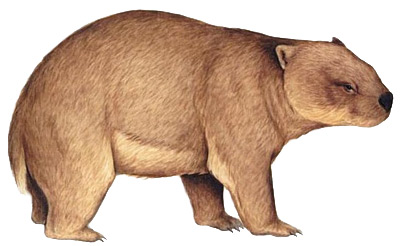
|
Search JoyZine with Google Site Search! |
Ramsayia magna
Ramsayia was a genus of marsupials named in honour of EP Ramsay, former Curator at the Australian Museum. The species name is Latin and means 'large'. This wombat was very large (although smaller than P. giga), probably twice as big as the living common wombat (Vombatus ursinus). Dawson (1981) reviewed the genus and described new material of R. magna, concluding that it was most closely allied to hairy-nose wombats (Lasiorhinus). Fossils of this creature date from the Lower Pliocene to the Upper Pleistocene. Ramsayia was about 2.3m. It is related to wombats of today, but was larger. Fossils of Ramsayia lemleyi date to the Pliocene. Those of Ramsayia curvirostris and R. magna are of the Pleistocene. Fossil remains of Ramsayia curvirostris have been found at Cuddie Springs, a semi-arid area of the northern part of New South Wales, and at Wellington Caves in central west NSW. The remains of many extinct megafauna have been unearthed in the locale. Solid proof of human occupation has also been found. The fossils at the site date to around 35,000 - 30,000 years ago, which was in the very late part of the Pleistocene. Judith Furby wrote an article titled Dinnertime at Cuddie Springs: hunting and butchering megafauna? Report prepared for the Brewarrina Local Aboriginal Land Council December, 1996. In it, she stated that in 1994, excavations at Cuddie Springs, near Carinda, exposed numerous bones of now extinct animals called megafauna. These animals included a giant flightless bird called Genyornis newtoni, a large wombat-like creature as big as a rhinoceros called Diprotodon, a kangaroo called Sthenurus as well as Ramsayia. The bones of a modern kangaroo are also found with the megafauna. The red kangaroo (Macropodus rufus) is thought to be the last remaining megafauna, though they are smaller today than they were thousands of years ago. A silcrete utilised flake was found beneath a Genyornis limb bone. Traces of blood were found near the used edges. A silcrete hammerstone was found with Diprotodon and Genyornis bones. Some radiocarbon tests indicate that the levels where the bones and stones are found together may date as far back as 40,000 years. In the conclusion of the report, Judith Furby states some important points. She says that the evidence definitely proves humans were hunting megafauna in addition to smaller game. However, she also points out that it has not been proven that humans caused the megafaunal extinctions in Australia. |
